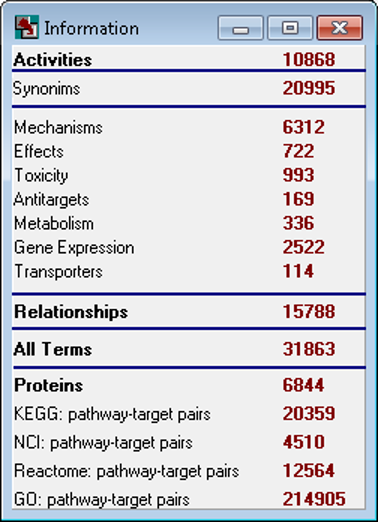Key features of PharmaExpert
PharmaExpert is an expert system taking into account the known relationships between pharmacotherapeutic effects and mechanisms of action of biologically active substances.
Fields of application: Analysis of the cause-effect relationships between the biological activities, estimation of possible positive and negative pharmacokinetic and pharmacodynamic drug-drug interactions, selection of compounds with the needed activity spectra predicted by PASS, identification of compounds with multiple mechanisms of particular pharmacological action.
PharmaExpert is designed to visualize and to analyze the prediction results of PASS and GUSAR software. It provides the following functions:
– reading the SD files containing information about the structures of organic compounds and prediction results of their spectra of biological activity provided by PASS, as well as the prediction results of (Q)SAR models of GUSAR;
– visualization of relationships between the predicted biological activities based on the known data about the causal relationships between them, and “target-pathway-effect” relationships;
– selecting compounds with desired biological activities in one or more SD files;
– analysis of possible positive and negative drug-drug interactions for individual pairs of compounds or for all compounds contained in the SD file;
– saving identified relationships between the activities and the results of the selection of compounds with desired biological activities in SD or TXT file.
PharmaExpert 2022 contains a knowledgebase with over 15 thousand of known interactions between biological activities, as well as the relationships between proteins, signalling/regulatory pathways (KEGG or Reactome), Gene Ontology biological processes and therapeutic and adverse effects:

All biological activities are divided onto seven types: (1) mechanisms of action; (2) pharmacological effects; (3) toxic and side effects; (4) interaction with antitargets; (5) interaction with drug metabolizing enzymes (inhibition, induction, interaction as a substrate); (6) changing gene expression of individual genes (increase, decrease); (7) interaction with transporter protein (inhibition, stimulation, interaction as a substrate).
Automatic search is provided for compounds acting on any of the mechanisms of action (or simultaneously on several mechanisms of action, up to ten) associated with the therapeutic effect or signalling/regulatory pathway (KEGG or Reactome) and biological process of Gene Ontology.
Analysis of possible drug-drug interactions is performed simultaneously for all seven types of biological activity.
